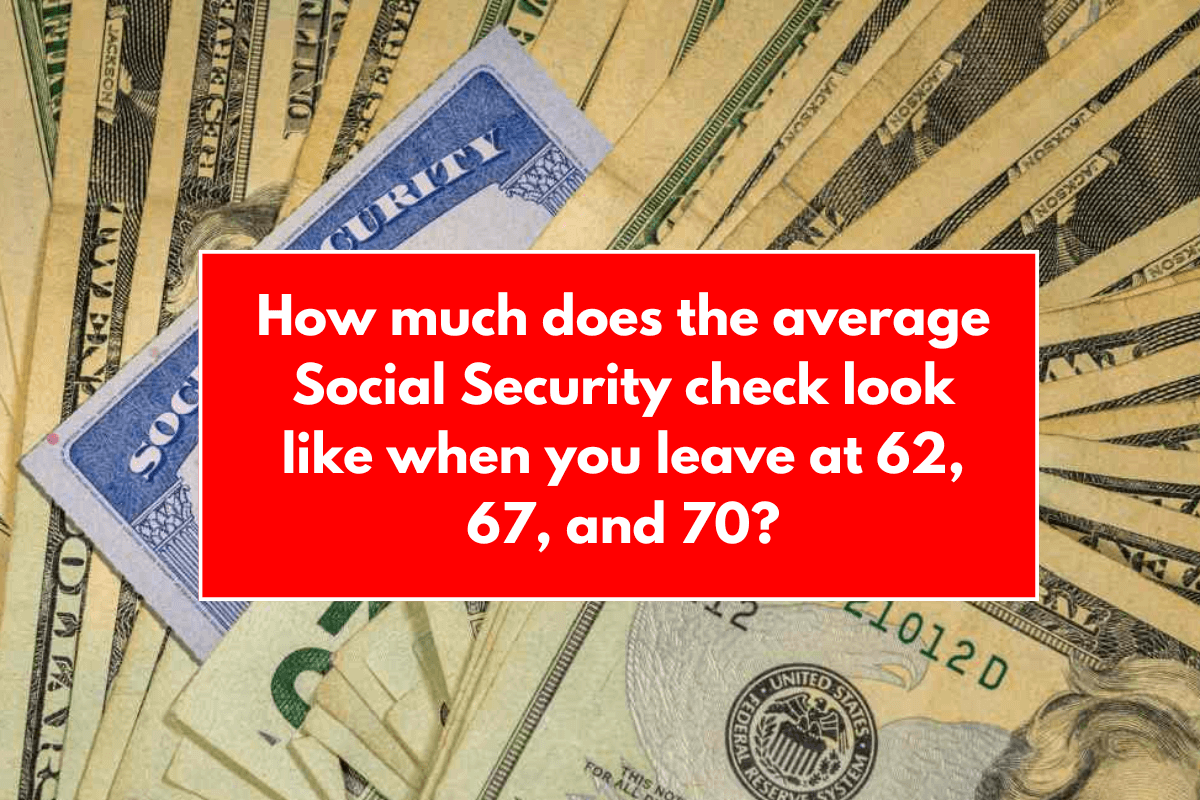Whether you are still working and planning your retirement or you are receiving Social Security, check if your payment amount is average or not.
It is very important to know how your claiming age affects your monthly and total Social Security payments. How much money you get from benefits can change a lot depending on when you start claiming.
Most likely, you’ll depend on Social Security income to help pay your bills in your golden years, whether you’re already retired or just starting out in your job. For most Americans, this kind of dependence is not just an option; it’s also the truth.
Social Security reliance
Gallup has been polling retirees and non-retirees for more than 20 years to find out how much they depend on Social Security as a source of income in retirement. What the results show is clear:
- About 80% to 90% of retired people rely on their monthly Social Security checks in some way to pay their bills.
- 76% to 88% of people who are not retired think they will need their Social Security payments when they retire.
This information makes a very important point clear: getting the most out of Social Security isn’t just a goal for most Americans; it’s a must if they want to be financially stable in retirement. Because so many people depend on this source of income now and in the future, it’s important to carefully consider when to start claiming Social Security to get the most out of it.
In the end, knowing about and making plans for Social Security can have a big effect on your retirement finances. Take the time to learn about your options and plan ahead for when you will start getting your rewards.
Maximize Your Social Security Benefits: Understanding the Key Factors
To get the most out of Social Security, people who will be retiring soon need to understand how their benefits are determined. One important thing to know is how the age at which you start getting benefits—early at age 62, at your full retirement age around age 66, or later at age 70—affects your monthly checks.
Four Key Components of Your Social Security Check
Some parts of America’s most popular retirement program may seem hard to understand, but the four main factors that the Social Security Administration (SSA) uses to figure out your monthly payments are pretty simple:
- Work History
- Earnings History
- Full Retirement Age
- Claiming Age
Your wages and work history are the first two factors, and they are closely linked. The SSA figures out how much to pay you each month by looking at your 35 highest-earning years, taking inflation into account. In theory, this means that the more you earn over the course of your lifetime, the more money you will get each month when you retire.

There is an important thing to keep in mind when figuring out your Social Security payments. The Social Security Administration (SSA) will take $0 out of your check for every year you haven’t worked for at least 35 years. Because of this punishment, you have to work for at least 35 years to get the most out of Social Security.
Understanding Full Retirement Age
The third important thing is when you can fully quit. This is the age at which you can start getting all of your retired worker benefit. This is the only part of Social Security that you can’t change because it depends on your birth year. It’s a set puzzle piece that everyone has to fit into.
The Impact of Your Claiming Age
Your claiming age is the fourth and maybe most important factor. The amount you’ll get from Social Security every month is based on this. You can start getting benefits as early as age 62, but waiting can make your monthly payment a lot more. Your benefit can grow by up to 8% for every year you wait to start getting it, from age 62 to age 70. The table below shows how important it is to be patient.
You can make smart choices that may greatly increase your Social Security payments if you understand and plan around these important factors. Remember that getting the most out of your benefits often takes time and thinking about the long run.
It is very important to know how your Social Security benefits change based on when you start getting them when you are planning for retirement. Here’s how your benefits will change based on when you were born and how old you are when you start claiming.
Social Security Benefits by Age and Birth Year
Depending on your birth year, the percentage of your full Social Security benefit changes as follows:
Birth Year: 1943-1954
- Age 62: 75%
- Age 63: 80%
- Age 64: 86.7%
- Age 65: 93.3%
- Age 66: 100%
- Age 67: 108%
- Age 68: 116%
- Age 69: 124%
- Age 70: 132%
Birth Year: 1955
- Age 62: 74.2%
- Age 63: 79.2%
- Age 64: 85.6%
- Age 65: 92.2%
- Age 66: 98.9%
- Age 67: 106.7%
- Age 68: 114.7%
- Age 69: 122.7%
- Age 70: 130.7%
Birth Year: 1956
- Age 62: 73.3%
- Age 63: 78.3%
- Age 64: 84.4%
- Age 65: 91.1%
- Age 66: 97.8%
- Age 67: 105.3%
- Age 68: 113.3%
- Age 69: 121.3%
- Age 70: 129.3%
Birth Year: 1957
- Age 62: 72.5%
- Age 63: 77.5%
- Age 64: 83.3%
- Age 65: 90%
- Age 66: 96.7%
- Age 67: 104%
- Age 68: 112%
- Age 69: 120%
- Age 70: 128%
Birth Year: 1958
- Age 62: 71.7%
- Age 63: 76.7%
- Age 64: 82.2%
- Age 65: 88.9%
- Age 66: 95.6%
- Age 67: 102.7%
- Age 68: 110.7%
- Age 69: 118.7%
- Age 70: 126.7%
Birth Year: 1959
- Age 62: 70.8%
- Age 63: 75.8%
- Age 64: 81.1%
- Age 65: 87.8%
- Age 66: 94.4%
- Age 67: 101.3%
- Age 68: 109.3%
- Age 69: 117.3%
- Age 70: 125.3%
Birth Year: 1960 or later
- Age 62: 70%
- Age 63: 75%
- Age 64: 80%
- Age 65: 86.7%
- Age 66: 93.3%
- Age 67: 100%
- Age 68: 108%
- Age 69: 116%
- Age 70: 124%
Data source: Social Security Administration
Understanding the Average Social Security Benefit at Ages 62, 66, and 70
In spite of the wide range in payout rates, there are pros and cons to claiming at each age within the normal range (62 to 70). But for the first group, ages 62, 66, and 70 tend to be the most popular. Let us look at why:
Age 62: If you start early, you’ll get rewards faster, but at There are three important ages to think about when choosing when to start getting Social Security benefits: 62, 66, and 70. Let’s look at the reasons why retired workers might pick these ages and answer the most important question: What is the typical Social Security payment for people 62, 66, and 70 years old?
Age 62: The Early Bird
The Social Security 2023 Annual Statistical Supplement says that the most common age for new claims is still 62. A big 27.3% of new claimants in 2022 decided to start getting benefits at this age. Their main reason for making this choice was simple: they didn’t want to wait to get their money.
This choice has a military side to it as well. According to the Social Security Board of Trustees Report for 2024, the Old-Age and Survivors Insurance Trust Fund (OASI), which helps old workers and their families, may run out of money by 2033. It’s possible that benefit cuts of up to 21% will be needed to keep payments going until 2098 if this happens. Some people believe that starting to get benefits early, at age 62, is a good way to avoid future cuts.
Age 66: The Full Retirement Age
When retirees choose to claim their benefits at age 66, they get all of their estimated benefits. For people born between 1943 and 1954, this age is the Full Retirement Age (FRA). Claiming at this age strikes a balance between the need for instant income and the benefit of not having to deal with the cuts that earlier claimants had to deal with.
Age 70: Maximizing Your Benefits
When seniors wait until they are 70 years old to start collecting Social Security, they can get the most money each month. Your benefits go up by about 8% for every year you wait past your FRA. This method can lead to much higher monthly benefits, giving you a bigger stream of income when you retire.
Average Benefits by Age
Knowing the average perks can help you make a better choice. The exact numbers can be different, but here’s a rough idea:
- Age 62: The average benefit is less because of fines for filing early.
- Benefits are at their full amount when you turn 66.
- At age 70, benefits are much higher because retirement credits were put off.
In the end, when to start getting Social Security benefits relies on the person, their health, their financial needs, and their expected length of life. If you think about the good and bad things about each age, you can choose the best retirement age.
A big turning point comes at age 66 when it comes to getting Social Security. It was the second most popular age for new claimants in 2022, with 24.7% of people picking this age (not counting disability conversions). Retirees can greatly reduce the lasting cut to their monthly Social Security checks by waiting four years past the initial eligibility age of 62.
The Importance of Age 66
For individuals born between 1943 and 1954, age 66 is particularly crucial as it marks their full retirement age. This age has become a psychological benchmark for many retired workers, representing a point where they can draw benefits without facing early withdrawal penalties.
Maximizing Benefits at Age 70
On the other hand, waiting until age 70 to start getting Social Security payments can be appealing because it means getting more money each month. By waiting eight years after they first became eligible, retirees can increase their monthly benefits by a large 24% to 32%, based on the year they were born.
- Age 66: Benefits will be cut less permanently than if you claimed at age 62.
- Full Retirement Age: This is very important for people born between 1943 and 1954.
- Age 70: Gets the most money each month, with payments up to 32% higher than at full retirement age.
Deciding when to start getting Social Security payments can have a big effect on how much money you have in retirement. If you know the benefits of waiting until 66 or even 70 years old, you can make a better choice that fits with your long-term financial goals.
It’s one thing to talk about percentages; it’s quite another to turn those percentages into dollars.
Understanding Average Social Security Benefits by Age
The SSA’s Office of the Actuary posted a huge dataset earlier this year that showed the average Social Security benefit for retirees of all ages in December 2023. It’s important to keep in mind that this information doesn’t always show when workers started getting paid, except for when they were 62 years old. Instead, it just shows the average payout for workers who are retired and a certain age.
Average Benefits for Different Ages
- 62 years old: About 590,400 retired worker recipients aged 62 took home an average of $1,298.26.
- Age 66: On the other hand, about 2.11 million retired workers aged 66 got an average check of $1,739.92.
- Finally, the 3.01 million retired workers who were 70 years old in December 2023 got an average check of $2,037.54.
- This is 57% more than what the average retired worker got at age 62.
The big changes in Social Security benefits depend on how old the retiree is when they start getting their checks are shown by these numbers. You can make better choices about your own retirement planning if you know about these differences.
But does this mean that people who want to get Social Security in the future should wait? To answer this question, I will use a thorough study that deals directly with the tricky claiming-age issue.















Leave a Reply